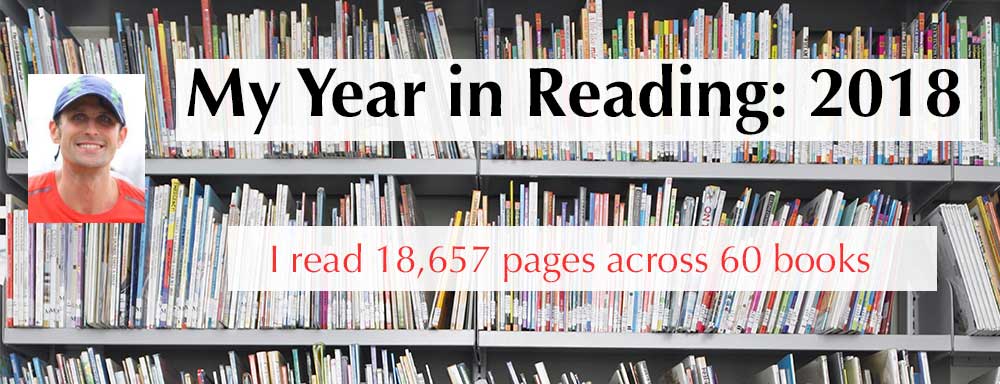I’m striving to be more conscious about what I read, how I learn from books and articles, and how I apply those lessons to my life, my work and my projects. So, in the spirit of that, I’m continuing a tradition I started in 2017 by offering up my year in reading for 2018.
Unlike my 2017 edition, I’m also including my article reading soo, which I track using Pocket at the start of the year and Instapaper since August. As an added bonus, I’m also sharing a few ways to do your own data-driven year in reading using some open source code I’ve created or you can sign up at XXXXXX to use the online tool once it is available.
Topline Numbers
2018 was good year for me and reading.
Book Reading Numbers: I read 16,749 pages across 60 books. My average rating on books I rated was 3.86. Compared to 2017, I read fewer novels and more non-fiction. My non-fiction reading tended a bit more towards science and academic research than previous too. My biggest month of book reading was May in which I finished 8 books and over 2,000 pages.
As a Kindle reader, I’m fortunate to have a whole log of my highlights too. In 2018, I collected XX highlights from books I read.
Article Reading Numbers: By my account, I read 1785 articles. While I tend to bias my reading towards long-form books, I also did my fair share of article reading. Since I track my article readings with Pocket and Instapaper, I more or less know how many articles I read (or at least the articles I read and tracked via one of these apps).
Below is my data visualization of my year in reading book, the top books I read and my key takeways, my year in article reading and a few favorites. Finally, I conclude with a couple of thoughts on my reading habits and goals for the year to come.
Infographic: My Year in Reading Books: 2018
====== Goodreads Summary for 2018 ====== 60 total books read 16,749.0 total number of pages read Average Rating of 3.86 335.0 average number of pages per book
(NOTE: Goodreads site and API are giving different results. I’ve included the bigger number in the graphic)
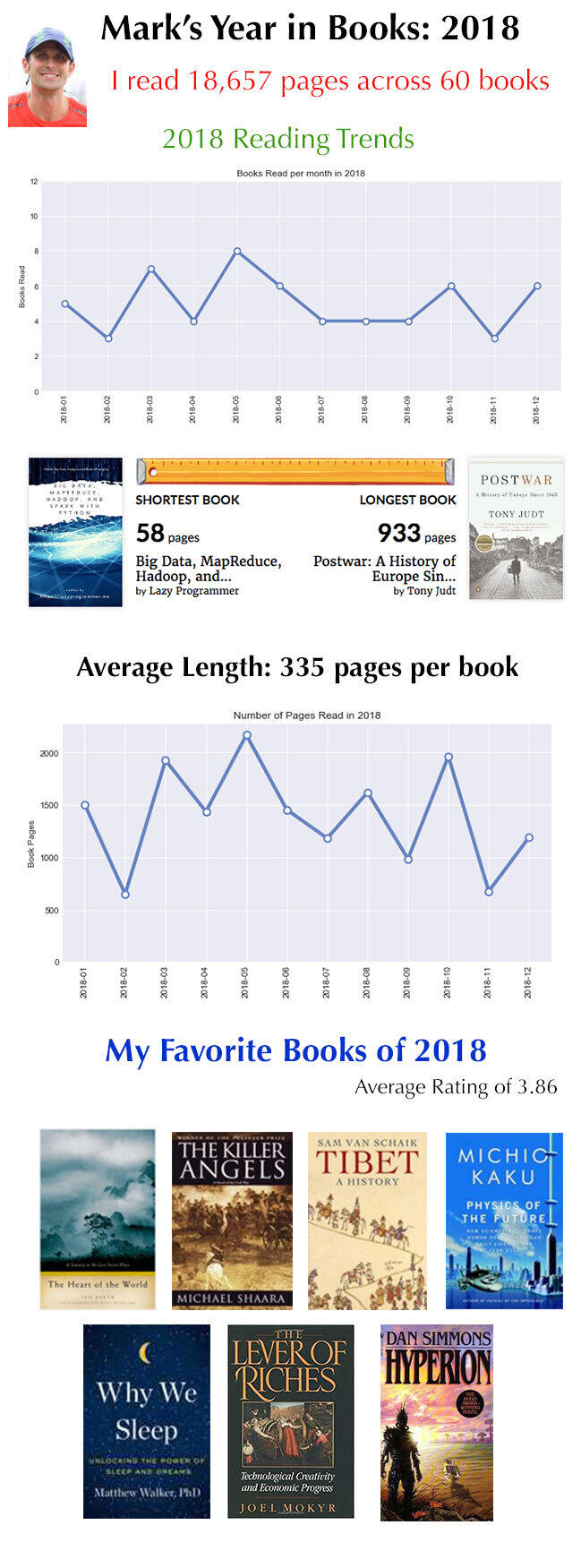
My Favorite Books from 2018:
I read a lot of great book this past year. Here are my favorites and a few honorable mentions:
Favorite Novel / Travel Book:
The Heart of the World: A Journey to the Last Secret Place by Ian Baker
This is a difficult book to categorize: part travelogue, part existential journey, part adventure, part history, part religious quest. The book follows the author’s adventures in search of an area uncharted and unmapped between Tibet and Nepal. Memory, life, and beautiful imagery abound in a book that truly transported me.
Favorite Book on Science and Technology:
Physics of the Future: How Science Will Shape Human Destiny and Our Daily Lives by the Year 2100 by Michio Kaku
Physist Michio Kaku uses the physical nature of the universe to predict the technologies (and science behind them) that will shape human lives and our planet. For example, he predicts that we will become a planetary civilization within 100 years, including our ability to a more complete master energy of our sun, and that we will create programmable matter.
Favorite Book on Self-Improvement and Habits:
Why We Sleep: Unlocking the Power of Sleep and Dreams by Matthew Walker
I started reading this book to understand why I suddenly started dreaming (or at least recalling my dreams). Since reading this book, I’ve come to realize how important sleep is to our health, performance, learning, creativity and more. Sleep is not for the weak; sleep is for the great.
Runners Up: “Peak Performance” by Brad Stulberg and Steve Magnus and “The Blue Zones” by Dan Buettner.
Favorite History Book:
The Killer Angels by Michael Shaara
This is a narrative account of the last major battle of the American Civil War. Told between key players. It’s the first-time I’ve taken a more personal perspective on a society split in two and the generals tasked with resolving it. Beautiful narrative through a rich tapestry of moments in American History.
Tibet: A History by Sam Van Schaik
This book provides a dense yet detailed history of one of Earth’s oldest and most cultured civilizations: Tibet. Well-written and flowing, it provided a great intro and context before my trip to Lhasa, Tibet.
Honorable Mention: Leonardo da Vinci by Walter Isaacson.
Favorite Book on Startups and Entrepreneurship:
The Lever of Riches: Technological Creativity and Economic Progress by Joel Mokyr
Mokyr argues that economic growth, societal progress, and historical success can’t be defined simply in terms of trade and exchange, since one of the key aspects to the rise of countries and societies has been the ability for technological creativity, i.e. science-backed innovation and invention. Remarkable book in the same spirit as Gun, Germs and Steel.
Favorite Sci-Fi Novel:
Hyperion by Dan Simmons
A classic in the sci-fi genre. This first book carries non-stop suspense as a group of intergalaxic pilgrims head to a planet to meet a mysterious and murderous being. As they journey, we hear the unique backstory of each of the characters and how their destiny ties in with that of the universe’s.
Runer Up: Roadside Picnic by Arkady Strugatsky.
Data Aside: Kindle Highlights
I’m still not quite sure what kind of “data story” my kindle highlights tell. I largely use highlights for own usage and followup.
In any case, here is my Kindle Highlights Summary for 2018:
- 4,086 total book highlights
- 91 total books highlighted
- 44.9 average number of highlights per book
- 340.5 monthly average
- 607 most in a month
- 88 least in a month
Overall, compared to 2017, I took less highlights in 2018 (5,531 vs. 4,086), and I highlighted less books (119 vs. 91). There appears to be some degree of correlation between number of highlights and if the book was rated highly or chosen as a personal favorite.
Here is a simple visualization of the highlighting trends:
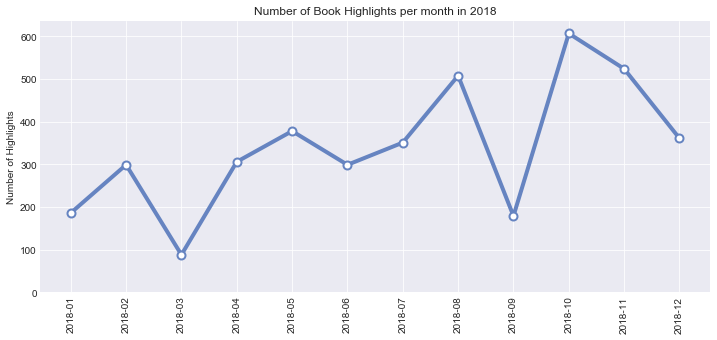
My Top Highlighted Books with Highlight Count:
- 327 in Why We Sleep: Unlocking the Power of Sleep and Dreams
- 233 in The Lever of Riches: Technological Creativity and Economic Progress
- 206 in Making Habits, Breaking Habits
- 185 in Peak Performance: Elevate Your Game, Avoid Burnout, and Thrive with the New Science of Success
- 183 in Skin in the Game
- 168 in Philosophy of Mysticism
- 147 in Your Blood Never Lies: How to Read a Blood Test for a Longer, Healthier Life
- 146 in The Surpisingly Simple Truth Behind Extraordinary Results
- 145 in New Developments in Goal Setting and Task Performance
- 137 in The Master Algorithm
- 130 in Physics of the Future: How Science Will Shape Human Destiny and Our Daily Lives by the Year 2100
- 120 in Deep Work
Going forward, I’ll be interested to see if I can tease out more of my actual reading patterns using my highlights behavior. For example, it’s not currently possible to get my reading stats directly from Kindle, except in a somewhat convoluted way, but perhaps we can combine the Goodreads log with timestamps of Kindle highlights to estimate actual reading time and reading speed.
Infographic: My Year in Article Reading 2018
In 2018, I became more conscious of my article reading and ensuring a degree of article reading tracking. I’m not quite as dedicated to tracking my article reading as my book reading. I also switching my prefered read-it-later tool from Pocket to Instapaper mid-year too. So my article reading stats are a bit fragmented.
I read (and tracked that I read) 1785 articles this past year. 732 article were read in Pocket, which I stopped using in August, and since then, I read additional 1053 in Instapaper.
It’s a bit difficult to summarize one’s article reading since it tends to topical and periodic, but using a word cloud based on words in title, here is what the first half of 2018 looked like from my Pocket data:
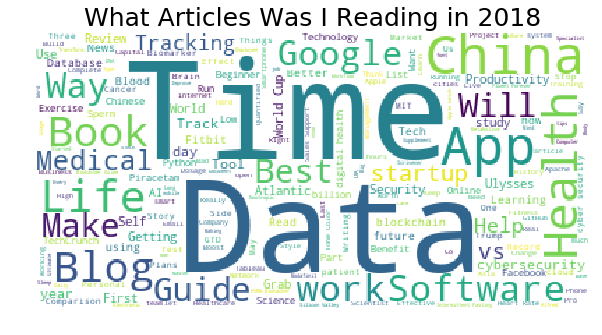
Here is the data story of my Instapaper data:
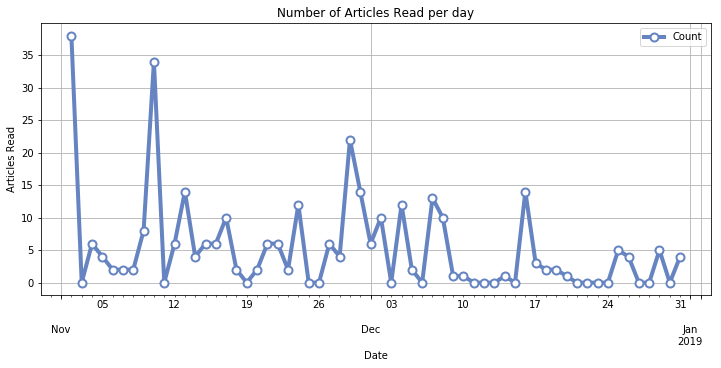
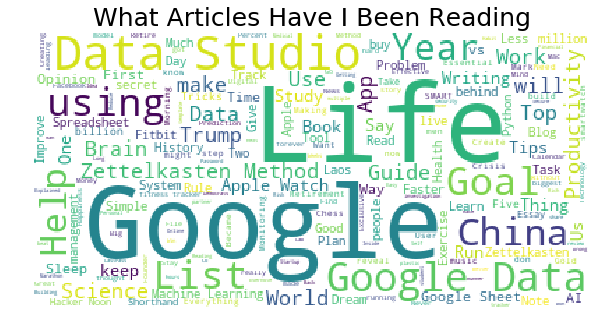
Lastly, since Instaper allows highlighting article, I’m able to see how my highlighting habits trend day to day too:
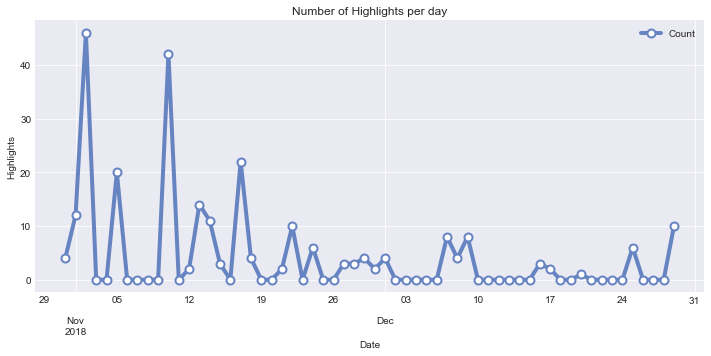
What lessons can I gain from this article reading data?
I’m a big fan of using tools that provide some additional data on my usage. While there are other tools to help you manage your article reading, Pocket and Instapaper provide some interesting statistics to quantify my reading habits too.
I’m still try to sort out what this data means and what kind of data story it can tell. It’s clear that I continue to read regularly about China where I spend at least part of the year. This year also saw the rise of Google Data Studio in my reading list and I expect to have much to share on that tool in 2019 as well, since I actively writing and creativing videos on using Google Data Studio for tracking and visualizing a life.
Overall, I expect I’ll have more to share on reading tracking in the year to come, especially as I attempt to quantify the genealogy of my creative ideas from studies and readings. Hopefully one day I can do more than just have a “read view mirror” perspective and proactively come up with a way to find relevant articles on topics I’m engaged in but haven’t see yet.
In Case You Missed It: A Selection of My Favorite Articles from 2018
Which were my favorite articles in 2018?
From 1785 article read, I liked 50 articles in Pocket and another 67 in Instapaper. Here is a selection of my favorites:
- Want to Remember Everything You’ll Ever Learn? Surrender to This Algorithm: Tale of a polish guy who invented one of the key technologies for learning and then went on to create a unique data-driven lifestyle all his own.
- How to biohack your intelligence — with everything from sex to modafinil to MDMA: Viral article on how a Silcon Valley based biohacker and tech entrepreneur pursues high performance through smart drugs and paid sex.
- The Strange Order of Things by Antonio Damasio review – why feelings are the unstoppable force
- The Final, Terrible Voyage of the Nautilus: What could go wrong with a guy who built his own submarine?
- Forecasts of genetic fate just got a lot more accurate: DNA-based polygenic scores are getting better at predicting intelligence, risks for common diseases, and more.
- If you’re so smart, why aren’t you rich? Turns out it’s just chance.: The most successful people are not the most talented, just the luckiest, according to a computer simulation model. Lucky me?!?
- What Are Screens Doing to Our Eyes—and Our Ability to See?
- I am a data factory (and so are you)
- Are You Effective or Just Busy? Calculate Your Churn Rate to Find Out: Cal Newport shares his analysis and technique for understanding if he is working on what matters, consistently.
- Exclusive: Fitbit’s 150 billion hours of heart data reveal secrets about health: A lot of beautiful data visualization from Fitbit and what it says about our health.
- Science is Getting Less Bang for Its Buck: We are still inventing stuff and making scientific discoveries, but it’s just taking longer and costing a alot more.
- China Used a Tiny Chip in a Hack That Infiltrated U.S. Companies: Did China manage to hack hardware and an international supply chain?
- The Collector’s Fallacy: Why keeping books and articles might make you think you have something but is in reality just an illusion of learning.
- Information Overload’s 2,300-Year-Old History: Something that seems so modern has pretty roots.
- Proof that you should get a life: Working more leads to less productive output.
- Scientists Reveal the Number of Times You’re Actually Conscious Each Minute: human brain oscillates in and out of focus four times per minute
- Personalized Nutrition by Prediction of Glycemic Responses: People ate the same things on the same schedules but had different metabolic responses. Is it finally time to declare generic, one-size-fits-all diets obsolete?
- Affective forecasting: Why you keep giving “future you” too much work: An exploration about why we suck at scheduling for our future (often tired) self!
- How to Live Better, According to Nietzsche: One of my favorite philosophers, Nietzche remains a useful guide to both thinking and joyful living for all of us even today.
- Digital immortality: How your life’s data means a version of you could live forever: Might our data be used to create a realistic avatar of ourselves?
Conclusion: Developing My Reading Habit Muscle
Overall, I’m happy with my continued habit of reading. If one of these articles or books sparked your interest, I highly recommend you check it out and send me a note with your takeaways. Sharing is caring!
Finally, I’d like to conclude my book year in review with three thoughts: one on how I built this and how you might build your own data-driven reading infographics, another on the reading habit and finally an idea on how I’m working to expand how I read by creating smart reading notes.
How I Built These Charts and Infographics
Last year I used Tableau for my year in reading data analysis. As I explained in How Do I Read?, Tableau can be a great tool for exploring your data or visualizing something. Increasingly though I’ve started to use a combination of Python’s Data Science toolkit and Google Data Studio for most of my personal data analysis and quantified self dashboards.
While the final graphic was assembled and editing using Photoshop, the underlying data collection, statistics and charts were all created using QS Ledger, an open source personal data aggregator and data visualization tool. The code is all in Python and shared via Jupyter Notebooks for ease of reproduction. I’ve provided one script for downloading and collecting your Goodreads data and a second for data analysis and data visualization. The second one in particular can be adapted to various things you want to explore or visualize.
Want to visualize your own reading data but not very technical? Drop me a comment below in the comments, social media, or send me an email. I’d like to turn this into a web-based public project and tool, but I’d like to get a few early users signed up first.
Develop a Reading Habit with Triggers and Implementation Intentions
I’m in an improvement group where we often discuss goals, habits and reading. I was recently asked how I read so much, and I can say that for me there are two key things I do: First, I priorize reading over other leisure activities and, second, when I need a break, traveling or relaxing in the evening, I read.
A few years ago I wasn’t reading that much, maybe only 10-15 books a year, but I consciously and mindfully worked on reading more. I developed using breaks and evening time as a trigger or cue for my reading habit. Research shows that habits depend a lot on triggers and that if you work on using those triggers through implementation intentions, you tend to be more successful in create new habits or removing bad ones. In my case, when evening comes or I am a bit tired out in the afternoon, I read. Sitting on a plane, train, boat, etc. or waiting on something, I read.
Implementation intentions are an important element in the science of goals and science of habits. The key aspect is three-fold: First, visualize what you’d like to do and become. Embrace this fantasy. Second, think about the obstacles, difficulties and present reality that might limit or hinder the pursuit of that goal. Third and finally, mentally contrast that fantasy with the reality to come up with an intentional plan towards your goal.
Moreover, having a kindle or any eReader ensures I’ve always got something new to potentially read from my queque. I often read a few books at the same time, and when a book bores me or doesn’t seem that good, I put it down and pick up something else.
Don’t Just Read, Take Smart Notes
Towards the begining of this year, I took a course on the learning how to learn, which I recently wrote up a summary in the Science of Learning. While I’ve learned a lot of things in my life and remain a life-long learning, this course and related studies revealed a few gaps in how I learn and ways to get better.
One important aspect for me is the learning strategy of elaboration. Often called the Feyman Strategy, basically, you take a new idea or concept you are trying to master and you strive to connect it with previous knowledge and put it your own words. Once you can teach the concept, you can claim to have learned in.
Towards the beginning of November I read one of the most impactful books I encountered this year: The Power of Systematic Notes: A Book Review of How To Take Smart Notes by Sönke Ahrens. While the book may not be a “favorite” read, it has lead to some important changes in my habit of reading. Specifically, I’ve stopped obcessing about collecting highlights and focus on a deliberate knowledge cycle where I convert my readings and rough notes into more permenant and insightful notes. This might be referred to as smart notes or in German as a Zettelkasten.
The key aspect of this methodology is to pull important ideas TO YOU from what you read and create a kind of atomic summary of that idea. In turn, the note should include a clear elaboration, references and a starting point of additional questions and perhaps a future manuscript.
Ultimately, I realized that far too many of books I really liked don’t have a remenant or notes to help me use it later. I intend to use this new framing of reading through a short knowledge cycle and creating smart notes to empower how I read going forward.
Unfortunately, this new change will inherently slow down how fast I read and add a bit more work to finishing a book. But already I’ve seen how this allows a richer reference and ideas repository for my writing and tech building.
Ahhh…900 books! I recently reached 900 books read, so after a good year of reading, I can also say that I’m making progress towards my 2000 books reading challenge. With my current yearly average of about 60 books a year, it’s still a goal that likely will take another 18 or so years to complete. That means a lot more good books to read, enjoy, and report on in the years to come!
What did you read and enjoy in 2018? Leave a comment and tell me what book I need to put in my reading queue soon!

